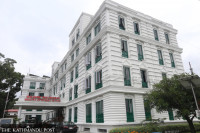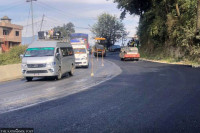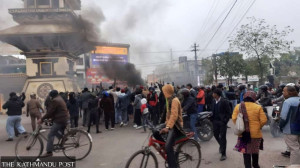National
9 lightning detection centres installed across the country
Every stroke of lightning bolt will now onwards be detected and recorded, as the country has completed installing nine lighting detection stations in different parts of the country.
Every stroke of lightning bolt will now onwards be detected and recorded, as the country has completed installing nine lighting detection stations in different parts of the country.
The lightning detection centres, the first in Nepal, have been set up in Tumlingtar, Biratnagar, Simara, Bhairhawa, Kathmandu, Pokhara, Nepalgunj, Surkhet and Dhangadi.
These stations will cover the entire country and gather data of incidents of lightning from all parts of the country.
According to the Department of Hydrology and Meteorology (DHM), installation has been completed in all locations and the DHM started testing them.
These centres will not only help the DHM to make weather forecasts but also will contribute to minimising loss of lives to lightning.
“These stations will help us in many ways. It will make our weather prediction accurate. They will also generate reliable data on occurrence of lightning,” said DHM Director General Rishi Ram Sharma.
With accurate data available on lightning, people sustaining physical injuries would be able to claim insurance as well, according to the DHM.
“Damages could not be claimed for the damage caused to electronic equipment like TV, radio, telephones, as earlier people could not produce proof that they were destroyed by lightning strikes. Now, we will have data which will make insurance claim process easier,” hoped Sharma.
However, members of the public have to wait for some time to access data on lightning strikes through DHM’s official website.
“We have started collecting data for internal purpose. We will be releasing data through our website after a month only,” said Sharma Locations for these stations were identified by conducting a preliminary study last year.
For data collection, interpretation and transmission, the DHM has trained its 25 staff. Data gathered over a long time can also help concerned authorities in formulating policies, said Sharma.
“These data gathered over a long period of time can help in mapping out highly prone areas and intensity of lightning. The government can then design policies based on these data,” said Sharma.
Once a lighting-prone locality is identified, the authorities can promote installation of lightning arresters in households to avoid damage.
These new lightning detection centres can also benefit the aviation sector by providing information about the movement of cumulonimbus clouds, which is mainly responsible for lightning.
“Clouds that cause lightning move from one place to another and we can track where they are heading by reading the direction and speed of wind. We can then warn the aviation authority to avoid that particular cloud,” added Sharma.
These new stations were installed at the budget of Rs 40 million and the contract was awarded to NowCast, a Munich-based German company.
According to the Ministry of Home Affairs, lightning strikes kill 150 people annually. The Chure and Mahabharat Hill ranges are highly vulnerable to lightning incidents, which mostly occur during pre-monsoon period.




 6.84°C Kathmandu
6.84°C Kathmandu







%20(1).jpg&w=300&height=200)






